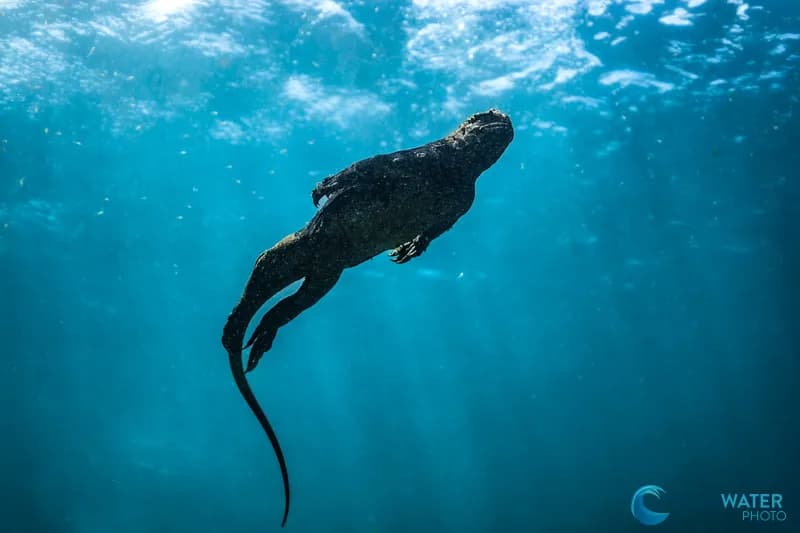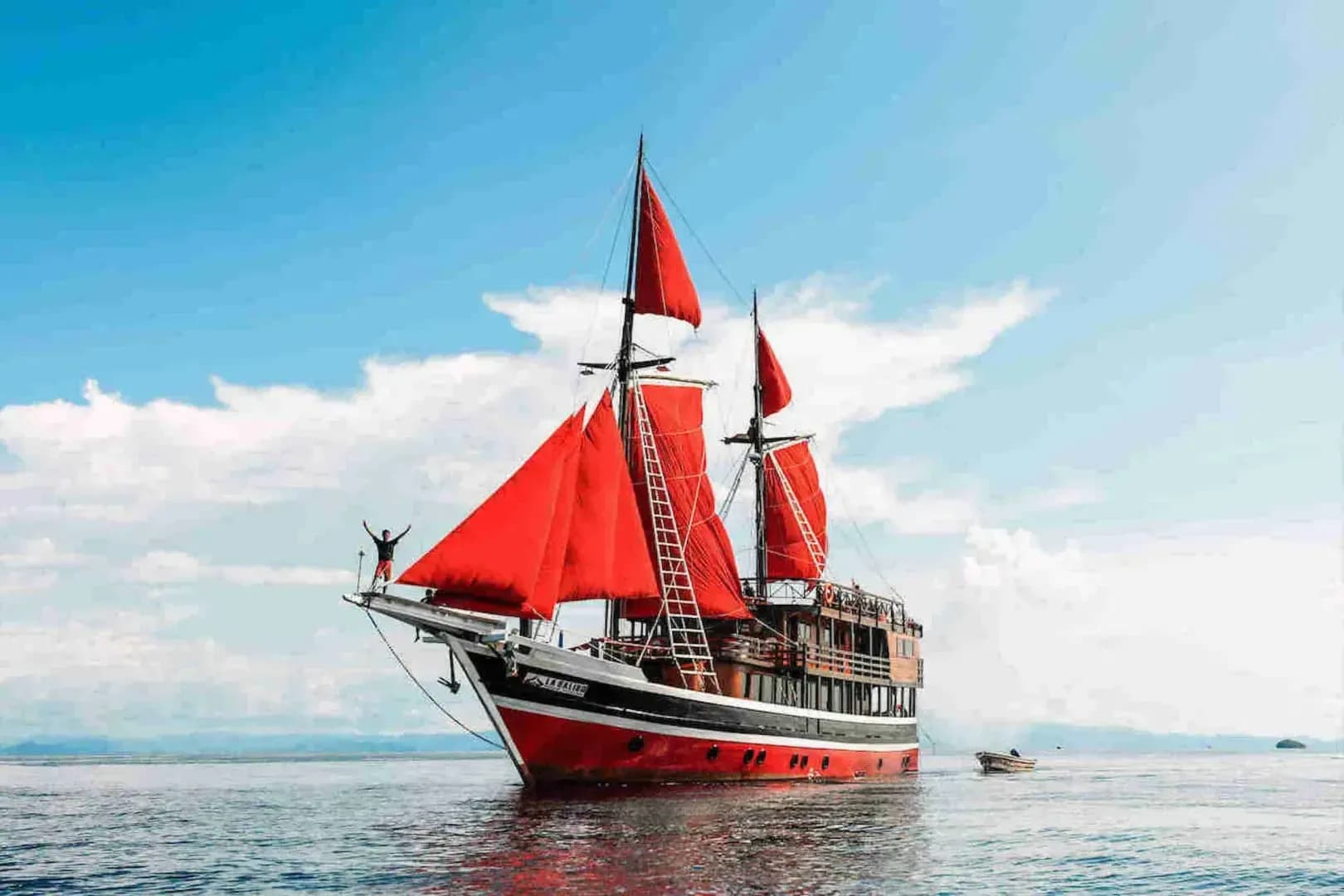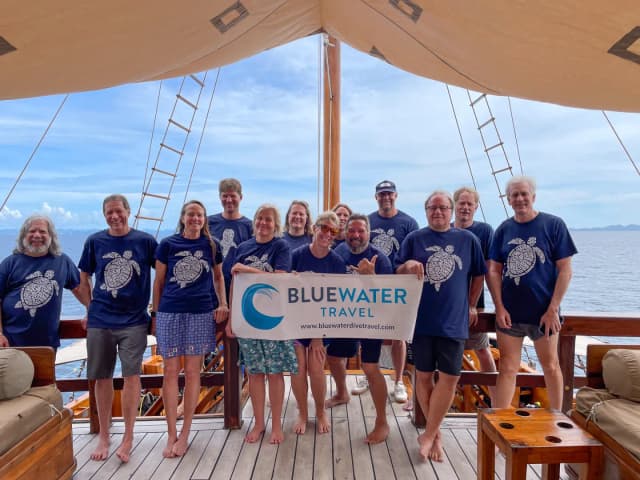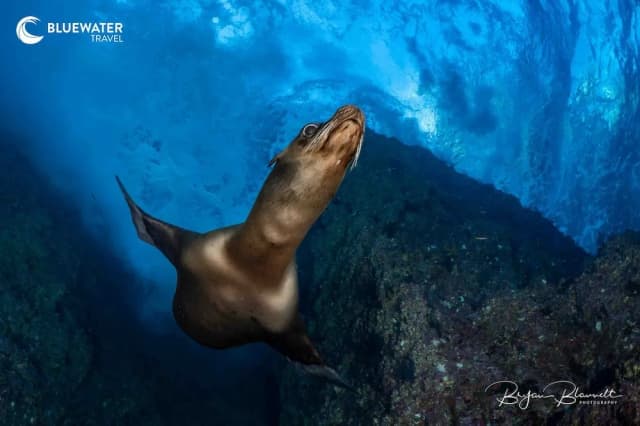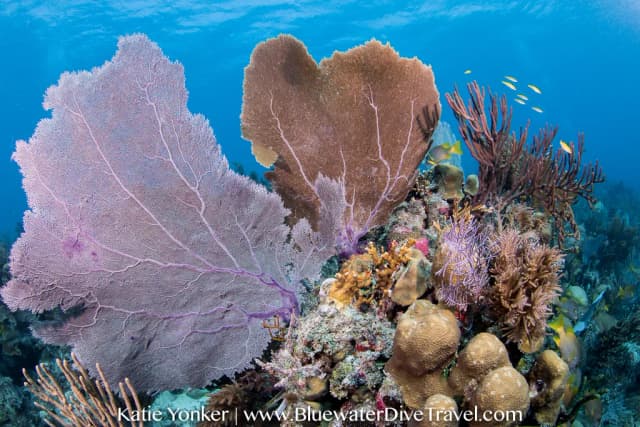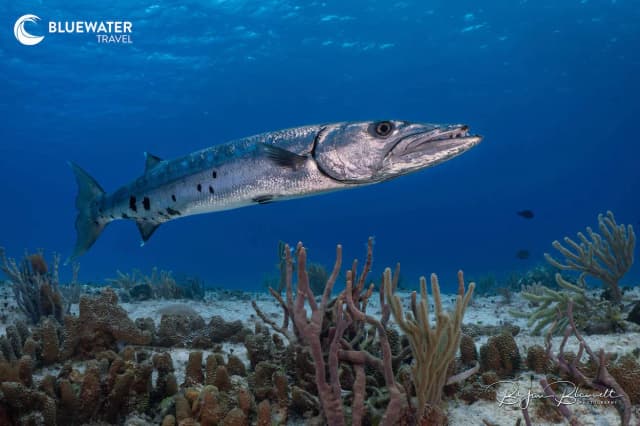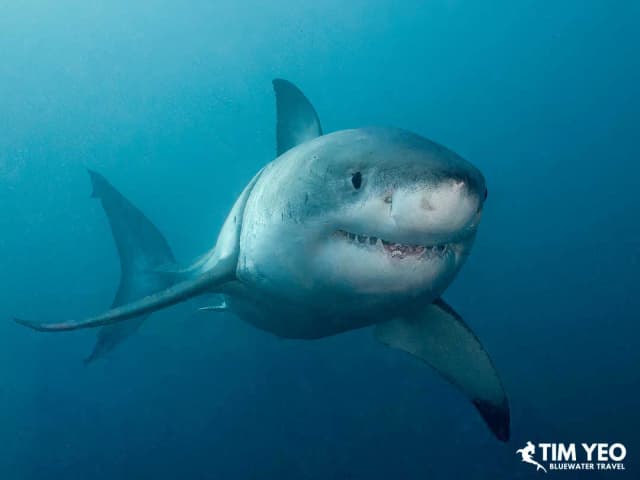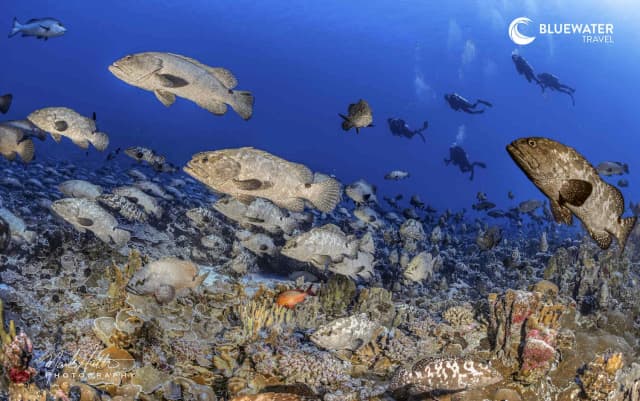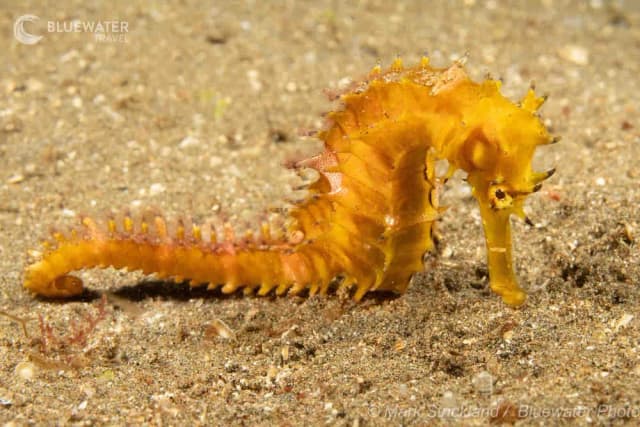Galapagos 2023 Trip Recap
Bluewater Travel's Underwater Photo Workshop May 2023
Words and photos by Nirupam Nigam
Camera gear: Canon EOS R8 in an Ikelite R8 housing with dual Ikelite DS 230 strobes, a Canon 8-15mm fisheye lens, a Canon RF 14-35mm rectilinear wide lens, a Canon RF 100mm macro lens, and the Mantis Sub Insta 360 RS Underwater Housing.
For as long as it has been known to human civilization, the Galapagos Islands have been shrouded in mystique and intrigue. This archipelago of rugged volcanic islands, located 500 miles west of South America, is reminiscent of a bygone era when reptiles dominated the planet. Giant Galapagos tortoises and Godzilla-faced marine iguanas were some of the breadcrumbs leading to Darwin's theory of evolution and remain an enigma to the lucky few that get to witness them today. In May 2023, the divers and adventurers on our Bluewater Travel underwater photo workshop became some of the lucky few to witness the incredible diversity that the hand of evolution has produced in the middle of the Pacific.
The Galapagos Master at Punta Vincente Roca - Home of the Mola Mola (L). A Land Iguana at North Seymour Island (R)
Arriving To San Cristobal
As with some of the world's other top dive destinations - getting to the Galapagos is not always easy. To fly into San Cristobal, the home of the Galapagos Master liveaboard, one must first fly to Quito or Guayacil, Ecuador. From there it's a short, 2-hour flight to San Cristobal. It can be a good idea to give yourself a few days for layovers when planning a trip to the Galapagos in the case of lost baggage or worse, storms. While the Galapagos isn't known for its bad weather, some of our group was delayed in Houston due to heavy rain and thunder. While almost all of us made it to San Cristobal eventually, two of our group needed to catch the boat on the second day of the trip at Seymour Island. It can be very fortunate to have a backup airport built into a dive trip, as this is not the case with most destinations.
Sunset over Isabela Island
The Underwater Photoworkshop Begins!
As our group gathered on Day 1 at the pier at San Cristobal, we were surrounded by the rambunctious barks of Galapagos Sea Lions. Shortly after, we boarded the dive pangas that we would use for the remainder of the trip and were whisked away to the Galapagos Master. Christened Deep Blue, the vessel is made for divers. It has a large dive deck on the stern where divers can suit up. The cabins are air-conditioned and relatively spacious with large en suite bathrooms, and there is a nice, large classroom in the bow of the main deck. Our group totaled 17 underwater photographers, video shooters, and divers, yet the vessel had plenty of space for us all to store camera equipment and set up before the dives.
While this trip was an underwater photoworkshop, we welcome all sorts of divers - photographers or not! Our group had a wide range of experience levels from newer photographers to seasoned, salty enthusiasts. People carried everything from smartphone housings to GoPros to full frame mirrorless cameras. I personally was testing a few exciting new cameras like the Canon EOS R8 budget-oriented full frame mirrorless camera and the Insta 360 RS in a Mantis Sub Housing. Along with our dive schedule of four dives a day, divers in our workshops have the opportunity to work one on one with our photo instructors. During our workshop to the Galapagos, I gave a one hour lecture on topics that appealed to all our guests - everything from GoPro video to introductions to underwater photography to advanced Adobe Lightroom techniques. At the end of the trip, we have a friendly underwater photo & video competition where the crew judges our content - and the winners win some Bluewater merch!
The route we have designed for our workshop ensures that divers are able to experience every aspect of the diversity the Galapagos has to offer. From the cold waters of the Cromwell current to the tropical waters of Wolf and Darwin, the goal is to witness as many unique animals as we can. The map below outlines our trip in the Islands with each day-long leg represented by a different color.

But before we could take photos, we needed to do a check-out dive in the harbor to make sure everyone was proficient at releasing surface marker buoys. Diving in the Galapagos is some of the most difficult of any of the workshops we offer. There can be strong currents, heavy swells, and cold water. While it is still comfortable and nice diving, it's important to be prepared for any situation. Due to the strong surge in the harbor from storms brought in by the brewing El Nino, our group decided to do a second checkout dive the next morning as we ventured to Seymour Island. For anyone who has not had much experience with surface marker buoys, it was great to get a second chance to get all our equipment situated.

A moray eel on our second checkout dive at Seymour Island (L) &A playful Galapagos Sea Lion photographed by Rolando Magni (R)
Seymour Island: Exploring Another Millenia
North Seymour Island is a window into the world Darwin visited the first time he set foot in the Galapagos. As we motored to the island, we woke up to a sunrise filled with frigate birds, blue-footed boobies, and gulls. Our guide Geoffrey, brought us onto a rocky shore covered in sally lightfoot crabs and nesting frigate birds. We spent the morning walking along a beautiful trail through dry brush and cacti witnessing some of the legendary animals the Galapagos had to offer - including nesting blue-footed boobies and bright yellow land iguanas. We even witnessed two large male iguanas fighting over territory in an intricate dance!
Male land iguanas size eachother up (L), A bluefooted booby, and a female frigatebird (R)
Darwin Island: The Rock At The Edge Of The World
After picking up our remaining passengers delayed by weather, we motored through building swells to the remote rocking outcropping that is Darwin Island. Although the arch is no longer there, "Darwin's Pillars" frame the single site on the island - a series of submarine shelves swept by a strong current that attracts whale sharks and hammerheads. Surprisingly, the current was actually fairly mild and we were able to do many of the dives free swimming - rather than holding onto rocks as many experienced Galapagos divers are used to. Although we did see a few hammerheads, they remained rather elusive. The highlight of Darwin was the warm (83F!) blue water and countless sea turtles feeding among the coral. On our second day at Darwin we experienced an unfortunate and unpredictable medical issue. With safety being the top priority, we decided to motor back to Isabella to drop off our afflicted guest so that she could receive proper medical care. Fortunately, she was able to safely recover and return home. Everyone in the group was very understanding, supportive, and helpful which greatly eased the process of a medical evacuation.

One of the many sea turtles at Darwin's Arch (L) & A beautiful sea turtle photographed by Sharron Bonnafoux (R)
Isabela Island And Roca Redonda
After the medical evacuation, we decided to dive where the speedboat picked up our guest on a lesser-dived area of the north side of Isabella Island. The site features large schools of yellow-tailed surgeonfish and we witnessed Galapagos penguins and flightless cormorants for the first time while diving a shallow lagoon.

A Galapagos penguin in a shallow lagoon photographed by Robert French
Following the lagoon, we decided to spend a day looking for hammerheads again at Roca Redonda. Roca Redonda is a remote rock off of Isabela Island. It is an advanced site with heavy surge known for streams of natural gas bubbles, called fumaroles. It truly feels like you are diving on a volcano that is ready to blow! We managed to see a few hammerheads in the distance as well as schools of barracuda and other beautiful fish.

Schools of Yellowtail Surgeonfish (L) & A hammerhead at Roca Redonda photographed by Eduardo Nadal (R)
Punta Vincente Roca: Home Of The Mola Mola
After an exciting adventure at Roca Redonda we moved the boat to the famous Punta Vincente Roca where we were able to go for a panga ride. As we approached the island we witnessed the incredible site of Galapagos penguins, Galapagos sea lions, sea turtles, flightless cormorants, blue-footed boobies, and marine iguanas all coexisting on the same coastline!
Galapagos Sea Lions and Galapagos Penguins Coexisting
The following morning we dived deep to look for the elusive mola mola. One of our groups encountered two! And both groups got to study the weirdest fish in the Galapagos - the red-lipped batfish. Punta Vincente Roca was also the home of the largest aggregation of sea turtles I have ever seen as well as the harlequin wrasse. Harlequin wrasse are decorated with a unique pattern resembling a koi fish.


Harlequin Wrasse (L), A sea robin photographed by Fern Cunha with her trusty GoPro & A red-lipped batfish photographed by Bill Maki (R)
Fernandina: Home Of The Marine Iguanas
Charles Darwin was no fan of the Galapagos marine iguana. They are objectively ugly creatures with dark, pudgy faces and an insatiable appetite for sea lettuce. Yet, they are extremely charismatic and fun to watch, hopping from rock to rock to satisfy their hunger. After a successful day at Punta Vincente Roca, we moved to the volcanic island of Fernandina, the home of marine iguanas. We started the day with two deeper, cold (72 F) dives in the Cromwell current. We saw lots of blue-striped nudibranchs and red-lipped batfish. Around noon, the iguanas all began to enter the water and swim towards shallow "fields" of green sea lettuce. Our final dive of the day was a long dive watching the iguanas graze and climb over each other to reach the best feeding grounds. It was an incredible experience to be surrounded by hundreds of marine lizards.
A fish living in the colder Cromwell Current (L), Marine Iguanas Graze in Shallow Water & A Marine Iguana travels to the surface to breath (R)
Cabo Marshall: A Manta And More
For the rest of the afternoon, we made our way around Isabela Island to Cabo Marshall - a site famous for Manta Rays. Sure enough, many in the group got to witness a couple large mantas swim over as we dived along steep slopes with clear, blue water. The other highlight of Cabo Marshall ws the large schools of fish and the many white tipped reefsharks swimming from hole to hole in the reef.

A beautiful reef at Cabo Marshall (L), A school of creole wrasse at Cabo Marshall & A manta ray photographed by Serge Bonnafoux, the winning photograph in our underwater photo contest! (R)
The Galapagos is one of the best places to encounter manta rays. Check out our list of the Best Manta Ray Diving.
Cousins Rock: SeaHorses And Sharks!
Our final dive of the trip might just have been the best dive of the trip. What started out as a slow meander along the steep wall of a remote rock off of Santiago Island, quickly turned into an action-packed dive! Along the wall, we witnessed multiple white-tipped reef sharks as well as a couple of seahorses!
A hawkfish hiding in black coral (L) & A white tipped reef shark swims along the wall at Cousins Rock (R)
Meeting The Giant Tortoises
The trip finished with the best for last - the opportunity to meet the famous Galapagos Giant Tortoises at the Tortoises sanctuary on Santa Cruz Island. The sanctuary is in the highlands of Santa Cruz Island, where wild tortoises come to enjoy shade and feed in the grassy countryside. We had the opportunity to witness exciting behaviors from mating to fighting. Afterward, we got to end the trip with a nice walk through town and drinks along the seaside.
Two male tortoises fighting (L) & A large male tortoise in the highlands of Santa Cruz Island (R)
While the Galapagos may not be the easiest place to dive or the easiest place to travel, every trip is undoubtedly an adventure.
The group!
Upcoming Galapagos Trips
Join our next photography workshops on the Galapagos Master:
Galapagos May 7 - 17, 2026 (10N)
Can't make it to one of those trips? See also the liveaboards available in the Galapagos or email us directly to book your next dream dive vacation!
New to liveaboards? Check out our article on the World of Liveaboard Diving.
OR
Check out our article on the Best Liveaboard Destinations for Beginners.





















